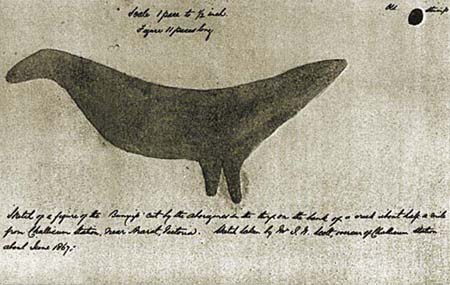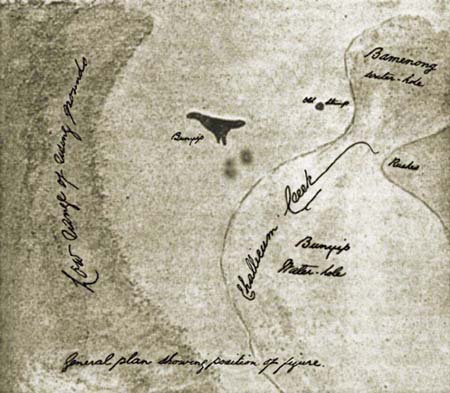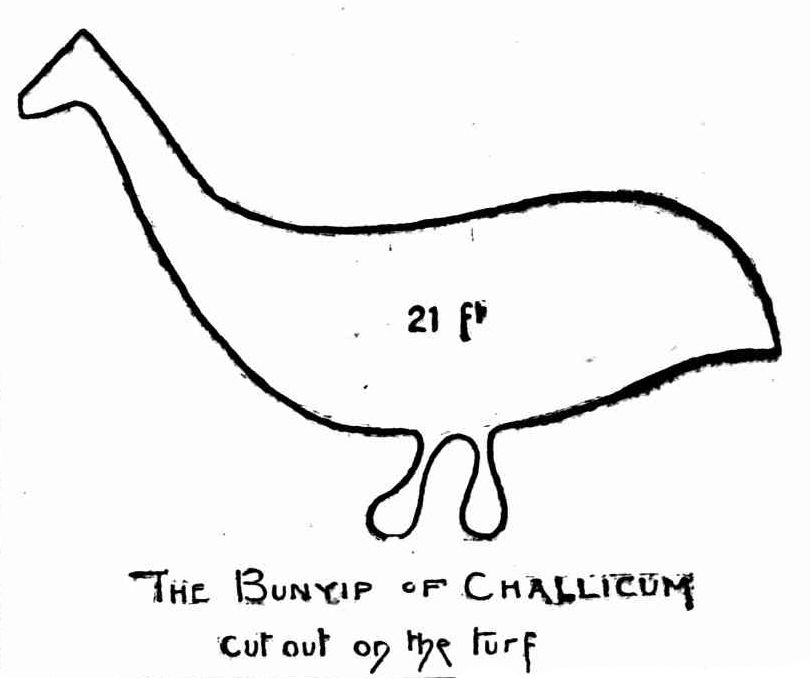1851 (pre): The Challicum Bunyip
Europeans first heard tales regarding the 'bunyip' -- a legendary water monster told of by the native Aborigines of Australia -- sometime after 1788, when the first penal colony was established in that country. At first, the stories of the water monster were ignored as the idle beliefs of a lesser people; but as strange bits and clues turned up that seemed to confirm some of the tales, many of the settlers started to believe that the 'bunyip' was a real animal, though misreported by the naive natives as more terrible than it likely was. It's with this fairly prejudiced take on the whole matter in mind that all evidence put forth for an actual water monster called a 'bunyip' must be judged.
One of the most famous bits of evidence -- sadly, now lost -- was first noted in 1851 in an article in the magazine Australasian. The article was called "The Bunyip of Challicum," and no author was given for it... but the magazine was edited by George Henry Wathen, and it is now believed he was the author. Wathen, you see, touches on the same subject in a book published in 1855 which uses very similar language as the article does in describing the matter; so it's seems very likely he produced the earlier article as well.
The 1851 article tells of a large figure of a 'bunyip' cut in the turf near three deep waterholes in Fiery Creek which, at the time of writing, was 6-1/2 miles from Challicum Station... hence the name given the figure: the Bunyip of Challicum. According to local Aborigine legend, sometime in the past one of the three waterholes had been inhabited by a bunyip. Apparently a group of natives were near the waterhole one day when the bunyip grabbed one of their number and proceeded to eat him; the other men attacked with spears and managed to kill the beast and drag it out of the water -- though there is also a less exciting version of the story just says the men found the bunyip dead to begin with; but where's the fun in that?
In either case, this was such an unusual event that the men traced an outline around the dead creature, which was later cut out of the turf after the body had been removed. This outline cutting of the bunyip continued to be maintained by the local Aborigines on a regular basis from that time on but, because of a very different way of keeping track of time and history on the part of the natives, the European settlers could never determine exactly how old the outline actually was. In 1851, when the article was written, the author noted that the outline had become partially overgrown, and it was now difficult to make out the feet and other extremities of the figure... but measurements set the figure as twenty-eight feet from tip to tip.
The next record I have of this bunyip outline, as I've already mentioned, comes from George Henry Wathen's 1855 book, The Golden Colony. This book details Wathen's travels in Australia in late 1854; on November 25 of that year Wathen visited Challicum Station and surveyed the bunyip outline near it. After he briefly describes being told the the story above about the origins of the figure in the turf, Wathen and a friend then visited the waterhole to view the figure. Wathen states that while he was there, he "sketched and measured it," then includes the following illustration:

The outline of the 'Bunyip', ca. 1854. [Picture sources here]
The figure was still there in 1867, when a Mr. R. E. Johns, who was Clerk of Petty Sessions at 'Moonabel' [now Moonambel] and who had a great interest in the art of the Aborigines of Australia, was able to acquire a sketch of the figure and a rough map of it's location from the overseer of Challicum Station, a Mr. E. W. Scott. Johns preserved the sketches in his notebooks, along with his own notes regarding the matter:


Scott's illustration and map. [Picture sources here]
As you can see, the illustration by Scott of the figure looks very different from the illustration provided twelve years earlier by Wathen. Here's the details from Johns' notes on the figure:
Bun-yip -- A belief in the existence of some gigantic, aquatic, and carnivorous animal in deep water-holes on creeks is universal. Among the Aborigines oF Victoria, South Australia and New South Wales they call this animal "bunyip" and cannot be induced to bathe in the holes it is said to frequent. Many Europeans, especially in the Mount Remarkable district of South Australia, also aver that they have seen it. At Challicum Station, near Ararat, Victoria, a figure is cut on the turf on the banks of the creek (see rough sketch attached) which the natives say was drawn long ago round the carcass of one of these animals as it lay there. I first heard of this figure in July, 1856, from Mr. W. H. Wright, Commissioner of Crown Lands at Geersley on the Wimmera. He told me that the aborigines were in the habit of visiting the place annually and tracing and clearing the outline of the figure afresh. I have since learned that the large water hole near it is said to be still haunted by a bunyip, and that an old shepherd positively asserts that he once saw it, and will not even now (1867) leave his hut after nightfall.
Unfortunately, even as the European settlers were learning about the bunyip outline, their very presence had signaled the eventual destruction of the unique artifact. The area of Challicum and Fiery Creek saw their first foreign settlers arriving in 1840 who were claiming parts of the land for their own use, mostly in raising sheep... and they considered the Aborigines as just local nuisances that were chased off the settlers' claims, often with guns. The numbers in the local tribes started to dwindle as they were denied their old hunting lands, and were forced to try and survive by stealing or begging from the European settlers... or by prostitution, which then spread diseases that also decreased the numbers of local Aborigines. by 1886, the last Aborigine living in the Fiery Creek area, a man known as Tommy Ware, died.
With no local Aborigines, no one was maintaining the bunyip outline anymore. Someone fenced off the spot for a while... but the grass grew until the shape was hard to make out. Then someone decided to take the fence down so their sheep could graze, and the hooves of the animals obliterated the last vestiges of the original figure. Later attempts to locate the site of the figure quickly showed that the single map that existed, Scott's 1867 sketch, was nowhere near accurate enough to actually pinpoint what was now invisible: and so the Bunyip of Challicum expired, for the second time.
What was the Bunyip of Challicum?
While the obvious answer is the simplest -- it was a bunyip because the people who saw and killed it identified it as such -- not surprisingly, the European settlers in Australia largely believed this idea was wrong, and generally for all the wrong reasons.
The first European guess came in the 1851 article, the first article that actually dealt with the outline of the Bunyip of Challicum. The anonymous author offered up two ideas regarding the figure's identity, the first being an observation that the shape looked like an emu... but an enormous emu, given the author's estimate of 28 feet from tip of nose to tip of tail. In making this observation, the anonymous author also dropped the fact that they had expected some form of saurian; so it's likely that the early European settlers' first ideas regarding the identity of bunyips in general had people looking for something like an alligator, an animal they were familiar with from other parts of the word that was deadly and associated with a semi-aquatic fresh water existence.
This is a fairly practical thought on the matter. The European settlers were still new enough to the country, and had seen enough unusual animals, that they couldn't ignore the possibility of another new creature; but at the same time, it made sense to expect from descriptions creatures similar to ones they'd seen before. 100 years later -- after the local Aborigines had died out, the figure no longer existed, and the flora and fauna of the continent were now well documented by the European citizens of the country -- it was a very different story.
In October 1957, anthropologist Aldo Massola reviewed some of the evidence regarding the figure of the bunyip near Fiery Creek... specifically, he talked about Johns' and Scott's investigation and notes, strangely leaving out all mention of the earlier articles on the matter in 1851 and 1855; there was a reason. After going over some history of the area and detailing the story of Johns' and Scott's investigation of the matter, Massola then gets to the main point of his article under a section subtly titled "The Bun-yip Myth":
"There appears to be little question of the occasional appearance of an animal in inland waters with which the aborigines were not familiar. Everything points to this animal being the South Eastern Australian Fur Seal, sometimes called the Eared Seal. It belongs to the species Arctocephalus tasmaniensis Scott and Lord and is not a true seal but a sea-bear. Unlike the seal proper, it has well formed ears, and loudly bellows or roars. It is as much at home in fresh as in sea water, and it has been observed by reliable witnesses miles from the sea."
Massola felt that the seal's "bellows or roars" explained the bellowing that was attributed to the bunyips. Massola's argument had very little supporting it: he stated that this particular seal had in fact been found miles inland in parts of Australia, but his earliest record of such was in 1872, and in a different part of the country. But from this fact and his assumption that these seals had traveled up Fiery Creek, Massola extrapolates:
"It is true that the coastal tribes must have been familiar with seals and often made a meal of them, for seal bones are common in coastal middens; but inland tribes, although no doubt they would have heard reports of them, would lie startled by the sudden appearance of one at a water-hole, or in hearing the unfamiliar bellow. Such an apparition would most certainly strike terror into the heart of the superstitious natives, and the no less superstitious, often illiterate, shepherds who tended the flocks in the newly occupied 'runs.'"
Mind you, Massola had no proof such an event had actually happened. In claiming that 'superstitious, often illiterate' shepherds could mistake the seal for a monster, Massola was attempting to discredit the old shepherd that Johns noted had made a claim of seeing the bunyip himself. It also ignores reports by the Aborigines that bunyips had actually killed people in the past; Massola's assumption those were not true goes unstated, but very clear, with his arguments. Overall, Massola's arguments rely on an agreed upon understanding that 'naive' natives and lessor educated Europeans were mistaking an identifiable animal for a monster... which is not proof.
Massola felt that Scott's illustrations of the figure was further evidence of the creature's identity as a seal, because it looks like a seal. But Massola also left the illustrations by earlier investigators out of his article, such as the illustration from Wathen above. And here's another illustration of the figure dating from an 1898 newspaper:

The Outline. [Larger version here]
By focusing on Scott's illustrations of the now lost figure, Massola attempted to make it look as if it was an earlier and more definitive copy of the figure; one that was far less emu-shaped in its appearance.
Massola also explained that the size of the figure was due to the Aborigines cutting the figure a little larger each year; so it had started much smaller and then grown over time to the 28 feet from tip to tip size. But Massola had no proof this was true. In the approximately fifty-year period that people were paying attention, the figure had not noticeably increased in size... nor did Massola have any form of proof that the Aborigines had actually been cutting it larger each year; it was another assumption. Had the figure grown in this way over time, the shape of the original animal would have been greatly distorted... which would mean Massola's assumption that the shape could indicate a seal would be very questionable if he was right about the figure changing over time!
Massola went on to make other culturally inappropriate guesses regarding the nature of the figure to the local Aborigines in his article, asserting as true a number of things he neither supplies a source for nor could have learned directly from the Aboriginies of the area who had died out and left no notes behind. Overall, Massola's article was a massive attack on the intelligence and history of the Aborigines that had created the figure, coupled with his own beliefs about what the 'bunyip' had to have been... and, unfortunately, at the time it was considered good science. It's largely thanks to Massola's deeply flawed 'study' of the Bunyip of Challicum that most people of European origin in Australia now believe old Aboriginal tales of bunyips to be based on either misidentified emus or seals.
While it is still possible that the earlier bunyip legends really are based on sightings of identifiable animals, simply ignoring the possibility of an unknown animal that may have now died out isn't the same as proving it impossible. In a newer study of the Bunyip of Challicum -- among other legends and evidence -- Professor Ian D. Clark of the Federation University proposed that one possibility is that the stories of bunyip are 'trace memories' passed down verbally though the generations by Aborigines of a now extinct species of giant emu; of course, this giant emu currently seems to only be evidenced by Aborigine tales and rock art, so it's not yet a provable idea... it mainly shows that there remains a mystery regarding the identity of the animals that the Aborigines feared and warned the new settlers from Europe about in the 17th century.
I will be surveying other reported legends and evidence of the bunyip in the future; let's see what sort of picture develops!
Anomalies -- the Strange & Unexplained, as well as my other website -- Monsters Here & There -- are supported by patrons, people like you! All new Anomalies articles are now posted for my patrons only, along with exclusive content made just for them. You can become a patron for just $1 a month!
|








